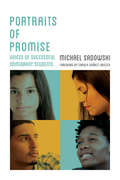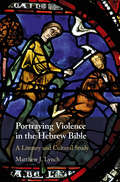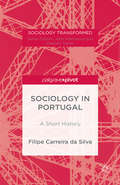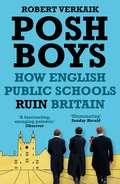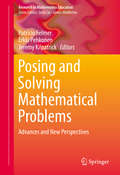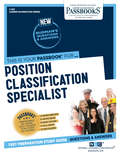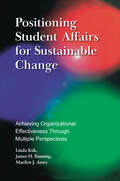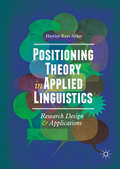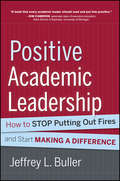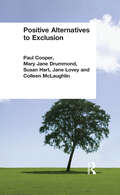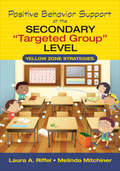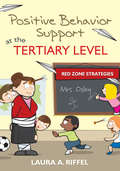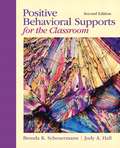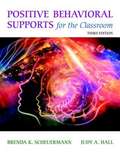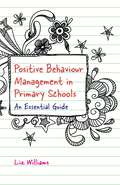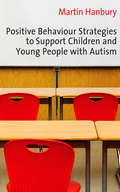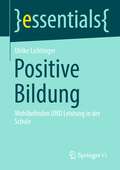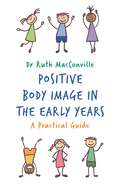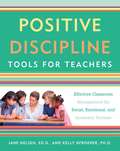- Table View
- List View
Portraits of Promise: Voices of Successful Immigrant Students (Youth Development and Education Series)
by Michael SadowskiBy 2040, more than 30 percent of students in the United States will be immigrants or the children of immigrants. What factors can help these young people thrive in school, despite the many obstacles they face? And how can school staff best support immigrant students&’ academic and personal success? In Portraits of Promise, educators hear from the ultimate experts—successful newcomer students. Drawing on the students&’ own stories, the book highlights the kinds of support and resources that help students engage positively with school culture, establish supportive peer networks, form strong bonds with teachers, manage competing expectations from home and school, and navigate the challenges of high-stakes testing and the college application process.
Portraying Violence in the Hebrew Bible: A Literary and Cultural Study
by Matthew J. LynchMost studies on violence in the Hebrew Bible focus on the question of how modern readers should approach the problem. But they fail to ask how the Hebrew Bible thinks about that problem in the first place. In this work, Matthew J. Lynch examines four key ways that writers of the Hebrew Bible conceptualize and critique acts of violence: violence as an ecological problem; violence as a moral problem; violence as a judicial problem; violence as a purity problem. These four 'grammars of violence' help us interpret crucial biblical texts where violence plays a lead role, like Genesis 4-9. Lynch's volume also offers readers ways to examine cultural continuity and the distinctiveness of biblical conceptions of violence.
Portuguese Sociology: A History (Sociology Transformed)
by Filipe Carreira da SilvaSociology in Portugal provides the first English-language account of the history of sociology in Portugal from 1945 to the present day. Banned by the fascist regime until 1974, the institutionalization of sociology as an academic discipline came relatively late. Understanding academic disciplines as institutionalized struggles over meaning, Filipe Carreira da Silva gives a genealogy of sociology in Portugal from its origins in the political-administrative interstices of a dictatorship, through the 'cyclopean moment' of the political revolution of April 1974, which brought about its swift institutionalization and subsequent consolidation in the new democratic regime, to the challenges posed by internationalization since the 1990s. Attempts to define Portugal itself, he demonstrates, have been at the heart of these struggles. Analyzing agents, institutions, contexts, instruments and ideas, Carreira da Silva shows in fascinating detail how the sociological understanding of Portugal evolved from that of a developing society in the 1960s, to that of a modernizing European social formation in the 1980s, to the post-colonial or post-imperial Portugal of today.
Portuguese as an Additional Language (SpringerBriefs in Linguistics)
by Ana C. NevesThis book focuses on Portuguese as an additional language and its young learners in threecase studies within the Portuguese-speaking world: Portuguese as a second language inCape Verde, Portuguese as a heritage language in Switzerland and Portuguese as a foreignlanguage in Macao SAR. The term “additional language” is used as an umbrella term for allthree contexts.An analysis of these three case studies is presented, with a focus on the organization of explicit and implicit language policies with regards to population mobility and also motivational issues, language attitudes and language use by the sample population.
Poruliyal Kotpaadu (Economic Theory) 12th Standard - Tamilnadu Board
by Training State Council of Educational ResearchPoruliyal Kotpaadu (Economic Theory) Textbook for the 12th Standard Students, preparing for Tamil Nadu State Board Exam.
Posh Boys: How English Public Schools Ruin Britain
by Robert Verkaik&‘The latest in the series of powerful books on the divisions in modern Britain, and will take its place on many bookshelves beside Reni Eddo-Lodge&’s Why I&’m No Longer Talking to White People About Race and Owen Jones&’s Chavs.&’ –Andrew Marr, Sunday Times &‘In his fascinating, enraging polemic, Verkaik touches on one of the strangest aspects of the elite schools and their product&’s domination of public life for two and a half centuries: the acquiescence of everyone else.&’ –Observer In Britain today, the government, judiciary and military are all led by an elite who attended private school. Under their watch, our society has become increasingly divided and the gap between rich and poor is now greater than ever before. Is this the country we want to live in? If we care about inequality, we have to talk about public schools. Robert Verkaik issues a searing indictment of the system originally intended to educate the most underprivileged Britons, and outlines how, through meaningful reform, we can finally make society fairer for all.
Posing and Solving Mathematical Problems
by Jeremy Kilpatrick Patricio Felmer Erkki PehkonenThis book collects recent research on posing and solving mathematical problems. Rather than treating these two crucial aspects of school mathematics as separate areas of study, the authors approach them as a unit where both areas are measured on equal grounds in relation to each other. The contributors are from a vast variety of countries and with a wide range of experience; it includes the work from many of the leading researchers in the area and an important number of young researchers. The book is divided in three parts, one directed to new research perspectives and the other two directed to teachers and students, respectively.
Posing for Portrait Photography: A Head-to-Toe Guide
by Jeff SmithPhotographers learn how to gauge the needs of their clients before placing them into a stale, preconceived #147;women’s,” #147;men’s,” or #147;children’s” pose that hardly fits the client’s personality or preferences. Provided with a two-pronged approach to fail-safe posing, photographers learn first to determine what the mood of the portrait should be and how to use an appropriate posing genre#151;traditional, casual, glamour, or journalistic. Photographers are then shown how that genre can be used as a basis to produce a pose that best suits the client, allowing them to create dynamic yet natural-looking pose that the subject#151;and the intended recipient#151;will love.
Position Classification Specialist: Passbooks Study Guide (Career Examination Series)
by National Learning CorporationThe Position Classification Specialist Passbook® prepares you for your test by allowing you to take practice exams in the subjects you need to study. It provides hundreds of questions and answers in the areas that will likely be covered on your upcoming exam, including but not limited to: Written communication; Analysis; Knowledge of the classification field; and more.
Positionen.Entwicklungen.Erfahrungen – 10 Jahre Junge Opern Rhein-Ruhr: Dokumentation der Konferenz zum Festival „Auf die Ohren, fertig, los!“
by Christiane Plank-Baldauf Merle FahrholzHören, Sehen, Staunen – in den deutschsprachigen Opernhäusern kann junges Publikum seit über zehn Jahren viel entdecken! Die vorliegende Dokumentation fasst die Ergebnisse der Konferenz „Auf die Ohren, fertig los!“ der Jungen Opern Rhein-Ruhr zusammen und gibt Einblicke in künstlerische Produktionsbedingungen, ästhetische Handschriften, Vermittlungsarbeit, institutionelle Rahmenbedingungen und fokussiert aktuelle Uraufführungen des Kooperationsverbunds. Die Ergebnisse der Konferenz werden zudem in einen übergreifenden Kontext gesellschafts- und kulturpolitischer Entwicklungen im Musiktheater für junges Publikum im deutschsprachigen Raum gestellt.
Positioning Student Affairs for Sustainable Change: Achieving Organizational Effectiveness Through Multiple Perspectives
by James H. Banning Marilyn J. Amey Linda KukAt a time of increasing student diversity, concern about security, demand for greater accountability, and of economic difficulty, what does the future hold for higher education, and how can student affairs organizations adapt to the increasing and changing demands? How can university leaders position existing resources to effectively address these and other emerging challenges with a sense of opportunity rather than dread? How can organizations be redesigned to sustain change while achieving excellence?As student affairs organizations have grown and become increasingly complex in order to meet new demands, they have often emphasized the expansion of their missions to the detriment of focusing on understanding their roles in relationship to other units, to reviewing their cultures and structures, and to considering how they can improve their effectiveness as organizations. This book provides the tools for organizational analysis and sustainability.Intended for practitioners, graduate students, interns and student affairs leaders, this book presents the key ideas and concepts from business-oriented organizational behavior and change theories, and demonstrates how they can be useful in, and be applied to, student affairs practice – and, in particular, how readers can use these theories to sustain change and enhance their organization’s ability to adapt to complex emerging challenges. At the same time it holds to values and perspectives that support the human dimension of organizational life.Recognizing the complexity of today’s organizations and the value of viewing them from multiple perspectives, this book follows the emerging practice of providing three general epistemological perspectives – the Positivist, Social Constructionist, and Postmodernist – for analyzing often paradoxical organizational structures, environments, and behavior.The book explores the environmental context of student affairs, and how the organization interacts with both the internal and external environments; examines the human dimension of organizations, through a review of individual attributes, human need and motivation, social comparison theory and organizational learning theory; presents the dimensions of structure and design theory and discusses why student affairs organizations need to think differently about how they organize their resources; considers the context and process of organizational change, and the dynamics of decision making, power, conflict and communication; addresses the role of assessment and evaluation; and new forms of leadership.Each chapter opens with a case study, and closes with a set of reflective questions.The authors have all served as practitioners within student affairs and now teach and advise graduate students and future leaders in the field.
Positioning Theory in Applied Linguistics: Research Design and Applications
by Hayriye Kayı-AydarThis book is about Positioning Theory (Davies & Harré, 1990) and its potential applications in bilingual and multilingual contexts involving teachers, learners, speakers, and users of a second/foreign or additional language. By using Positioning Theory as a theoretical lens and analytical approach, the author illustrates how various social and poststructural concepts in applied linguistics and language teacher education, including identity, agency, language socialization, classroom participation, and intercultural communication, can be investigated and better understood. The book adds a new perspective to the growing body of multidisciplinary literature in the areas of L2 teacher education and classroom learning, and includes step-by-step guidelines for positioning analysis, insights and implications for classroom practice, as well as suggested directions for future research. It will be of particular interest to language teachers and teacher educators, as well as students and scholars of applied linguistics more broadly.
Positive Academic Leadership: How to Stop Putting Out Fires and Start Making a Difference (Jossey-Bass Resources for Department Chairs #142)
by Jeffrey L. Buller"A book that every academic leader should read and put into practice." —Kim Cameron, associate dean of executive education, Ross School of Business, University of Michigan Praise for Positive Academic Leadership " Buller has produced a book that every academic leader should read and put into practice. Positive Academic Leadership pulls together an amazing array of scientific findings and practical guidelines that will be invaluable for academic leaders looking to improve themselves and their institutions." — Kim Cameron, associate dean, William Russell Professor of Management and Organizations, Ross School of Business; professor of higher education, School of Education, University of Michigan " If I had a magic wand and could make one wish for all of higher education, it would be that we had better institutional leadership. Whether one is a chair, dean, provost, president, or on the Board of Trustees, this book can make a world of difference in your ability to provide that leadership!" — L. Dee Fink, author, Creating Significant Learning Experiences; former president, Professional and Organizational Development Network in Higher Education " Buller's book brings hope for leadership in higher education by emphasizing the importance of a positive approach that empowers and inspires others. Positive Academic Leadership has the potential to transform higher education for the benefit of students, faculty, and ultimately our communities and our world." — Kina S. Mallard, provost and vice president of academic affairs, Carson-Newman University " Academic leaders who find themselves engulfed in negative thinking and considering only damage control scenarios for pressing issues will want to read this book. Employing what Jeffrey Buller calls 'positive academic leadership' is, I believe, essential to transforming feelings of despair into constructive leadership." — Mary Lou Higgerson, vice president for academic affairs, emerita, Baldwin Wallace University " I can't recall reading any book on leadership that is more applicable to the work of faculty development. Every academic leader—faculty member, chair, dean, or campus administrator—will benefit from Jeffrey Buller's evidence-based model and practices of positive academic leadership." — Mary Deane Sorcinelli, associate provost for faculty development, University of Massachusetts Amherst
Positive Alternatives to Exclusion
by Paul Cooper, Mary Jane Drummond, Susan Hart, Jane Lovey and Colleen McLaughlinPositive Alternatives to School Exclusion looks at what schools can do to build more harmonious communities and engage students - particularly those at risk of exclusion - more productively in all areas of school life. It describes the Positive Alternatives to School Exclusion Project, a multi-phase, collaborative initiative based at the School of Education, University of Cambridge.Drawing on the perspectives of staff and pupils, the authors provide detailed case studies of the approaches and strategies being adopted in a variety of settings (primary, secondary and FE) to foster inclusion and reduce and prevent exclusion. It also identifies a number of different frameworks, drawn from the case studies, which can be used by practitioners working in other settings to support their own reflection and development work. Particular importance is placed, throughout the book, on valuing the domain of personal experience in the life of the school community. The authors explore this theme in detail, suggesting ways in which it might become a priority focus of further development work in schools.
Positive Behavior Support at the Secondary "Targeted Group" Level: Yellow Zone Strategies
by Laura A. Riffel Melinda S. MitchinerSeal the gaps in student learning with targeted intervention Research on positive behavior support has focused largely on tier one, school-wide disciplinary policies, and tier three interventions tailored to highly problematic students. This leaves a gap in the middle. "Yellow zone", or tier two, interventions are an extremely effective way to address many challenging behavior and disciplinary issues in small group settings. Positive Behavior Support at the Secondary "Targeted Group" Level shows teachers how to identify the students who can benefit from tier two interventions and demonstrates how to create an implementation plan that delivers results. Focusing on proactive strategies rather than reactive solutions, Riffel and Mitchiner’s research-based techniques include: General strategies that can be applied at the individual student level, such as self-management, proximity control, and the Premack principle and peer mentoring Comprehensive action plans that anticipate the full range of disruptions that may occur A useful behavior rating sheet proven effective in improving student behavior "Funk Sway" For The Classroom: Using Feng Shui principles to create a classroom environment that enhances productivity, learning, and creativity Apply the techniques in this book to reduce challenging behavior, improve school climate, and improve outcomes for ALL students. "This book is easy to read, understand, and implement in any classroom or school. Teachers will be drawn to the resources that can be copied and used immediately! I can’t wait to apply some of these practices in my classroom!" Rachel Spenner, Sixth Grade Teacher Westridge Elementary School
Positive Behavior Support at the Secondary "Targeted Group" Level: Yellow Zone Strategies
by Laura A. Riffel Melinda S. MitchinerSeal the gaps in student learning with targeted intervention Research on positive behavior support has focused largely on tier one, school-wide disciplinary policies, and tier three interventions tailored to highly problematic students. This leaves a gap in the middle. "Yellow zone", or tier two, interventions are an extremely effective way to address many challenging behavior and disciplinary issues in small group settings. Positive Behavior Support at the Secondary "Targeted Group" Level shows teachers how to identify the students who can benefit from tier two interventions and demonstrates how to create an implementation plan that delivers results. Focusing on proactive strategies rather than reactive solutions, Riffel and Mitchiner’s research-based techniques include: General strategies that can be applied at the individual student level, such as self-management, proximity control, and the Premack principle and peer mentoring Comprehensive action plans that anticipate the full range of disruptions that may occur A useful behavior rating sheet proven effective in improving student behavior "Funk Sway" For The Classroom: Using Feng Shui principles to create a classroom environment that enhances productivity, learning, and creativity Apply the techniques in this book to reduce challenging behavior, improve school climate, and improve outcomes for ALL students. "This book is easy to read, understand, and implement in any classroom or school. Teachers will be drawn to the resources that can be copied and used immediately! I can’t wait to apply some of these practices in my classroom!" Rachel Spenner, Sixth Grade Teacher Westridge Elementary School
Positive Behavior Support at the Tertiary Level: Red Zone Strategies
by Laura A. RiffelHelp students move from the “red zone” to the success zone! How would you respond to a student who has tantrums or hits other students? These and other extremely challenging behaviors are identified as tertiary level or “red zone” by the Positive Behavioral Interventions and Supports (PBIS) model. Laura A. Riffel describes in teacher-friendly terms how to use this model to create an intervention plan to modify behavior that disrupts learning. Research-based tools for general and special educators, administrators, and counselors include: A data-driven approach to solving problems Techniques and strategies for collecting and analyzing data Methods for teaching replacement behavior Examples that show how to modify consequences
Positive Behavioral Supports for the Classroom
by Brenda K. Scheuermann Judy A. HallThe field of positive behavioral intervention and support is expanding rapidly, and the revised and reorganized second edition of Positive Behavioral Supports for the Classroom reflects the newest research and most exciting advances. With a new emphasis on the three-tier response-to-intervention model, the text continues to deliver readers an array of research-based strategies and techniques for strengthening appropriate behaviors and reducing challenging ones. Tackling both the "hows" and "whys" of behavioral management in the classroom, this text combines theory and practice in a way that helps students understand and apply effective strategies for behavioral support, assessment, and intervention in both school-wide settings and on an individual basis.
Positive Behavioral Supports for the Classroom
by Brenda K. Scheuermann Judy A. HallIn the new edition of Positive Behavioral Supports for the Classroom, pre- and in-service regular and special education classroom teachers get the latest in research and practice from the field of positive behavior interventions and support, with foundational principles and practices from applied behavior analysis. The book’s emphasis is on a multi-tiered system of support for developing positive behaviors in children and youth, preventing challenging behaviors, and managing challenging behaviors efficiently and effectively school-wide, in classrooms, and for individual students. A wide variety of concepts and techniques are covered, ranging from the most basic through advanced.
Positive Behaviour Management in Early Years Settings: An Essential Guide
by Liz WilliamsDrawing on her extensive practical experience, Liz Williams provides a highly accessible and much-needed guide to promoting positive behaviour in early years settings. In this book, she explains why children may act in the way that they do and how behaviour should be understood differently in children of different ages. She demonstrates that social and emotional capacities differ greatly in these crucial development years and how this impacts on the support needed at each stage. The book considers a host of factors influencing positive behaviour, such as environments and the importance of planning, and looks beyond the child to show the vital role that staff and parents have in promoting appropriate behaviour. Written in clear and understandable language, this book is full of ideas that early years workers can easily implement in their day-to-day work.
Positive Behaviour Management in Primary Schools: An Essential Guide
by Liz WilliamsThis highly accessible and much-needed resource sets out practical advice on positive behaviour management in primary schools, exploring how to support children effectively with their personal, social and emotional development. With an emphasis on implementable strategies, this book will give primary school teachers and staff an understanding as to why children may behave as they do, and what steps can be taken by the school to support a child's development. Considering a variety of factors that influence positive behaviour, such as environment, mental health, parents, and the importance of planning, this book is full of ideas that can be dipped in and out of for support in the classroom. Bite-sized and practical, this is a perfect book for busy teachers.
Positive Behaviour Strategies to Support Children & Young People with Autism
by Dr Martin HanburyTeachers in mainstream schools are increasingly accommodating pupils on the autistic spectrum in their classrooms, and this books offers advice on one of the most difficult aspects of teaching children and young adults with autism - understanding and managing their often challenging behaviour. This book: o explores issues surrounding behaviour support o supplies INSET materials for developing practice in behaviour management o contains self-audit tools for practitioners o gives practical advice on developing an appropriate learning environment o provides guidance on how to promote positive behaviour o contains tried and tested photocopiable material and practical resources. Essential reading for all teachers and teaching assistants working with pupils on the autistic spectrum, this book is based on the sound advice of an experienced practitioner who understands the reality of managing challenging behaviour in the classroom. Martin Hanbury is head of a special school, a regional tutor on the Webautism course at the University of Birmingham and works for the National Autistic Society.
Positive Bildung: Wohlbefinden UND Leistung in der Schule (essentials)
by Ulrike LichtingerIn diesem essential präsentiert Ulrike Lichtinger den Ansatz der Positiven Bildung. Ausgehend von dem Beispiel der australischen Geelong beschreibt sie, was es braucht, um Schulen so auszugestalten, dass sie zu Orten des Gelingens werden, Aufblühen und Potenzialentfaltung von Lehrkräften und Schülerschaft unterstützen und stärken. Dazu stellt sie das Rahmenmodell der Positiven Bildung vor und zeigt anhand einschlägiger Forschung auf, dass Leistung maßgeblich von Wohlbefinden getragen und beeinflusst wird. Das Konzept der Positiven Bildung greift all diese Linien auf, orientiert sich an PERMA, Seligmans fünf Säulen für Wohlbefinden sowie an den Charakterstärken und gibt konkrete Impulse zur Umsetzung in Schule und Unterricht in vier Handlungsfeldern.
Positive Body Image in the Early Years: A Practical Guide
by Ruth MacConvillePromote positive body image, build self-esteem and tackle body confidence issues in young children with this practical guide.Over a quarter of childcare professionals have seen body confidence issues in children aged 3-5 years old. This book explains how body image develops, highlights the warning signs of body dissatisfaction in children and provides guidance for early years practitioners on how to safeguard positive body image by building self-esteem and resilience. It also provides practical guidance and ideas for supporting healthy habits in children and creating bias-free settings.
Positive Discipline Tools for Teachers: Effective Classroom Management for Social, Emotional, and Academic Success
by Jane Nelsen Kelly GfroererMORE THAN 2 MILLION POSITIVE DISCIPLINE BOOKS SOLDThe Positive Discipline method has proved to be an invaluable resource for teachers who want to foster creative problem-solving within their students, giving them the behavioral skills they need to understand and process what they learn. In Positive Discipline Tools for Teachers, you will learn how to successfully incorporate respectful, solution-oriented approaches to ensure a cooperative and productive classroom. Using tools like "Connection Before Correction," "Four Problem-Solving Steps," and "Focusing on Solutions," teachers will be able to focus on student-centered learning, rather than wasting time trying to control their students' behavior. Each tool is specifically tailored for the modern classroom, with examples and positive solutions to each and every roadblock that stands in the way of cooperative learning. Complete with the most up-to-date research on classroom management and the effectiveness of the Positive Discipline method, this comprehensive guide also includes helpful teacher stories and testimonials from around the world. You will learn how to: - Model kind and firm leadership in the classroom- Keep your students involved and intrinsically motivated- Improve students’ self-regulation-And more!
